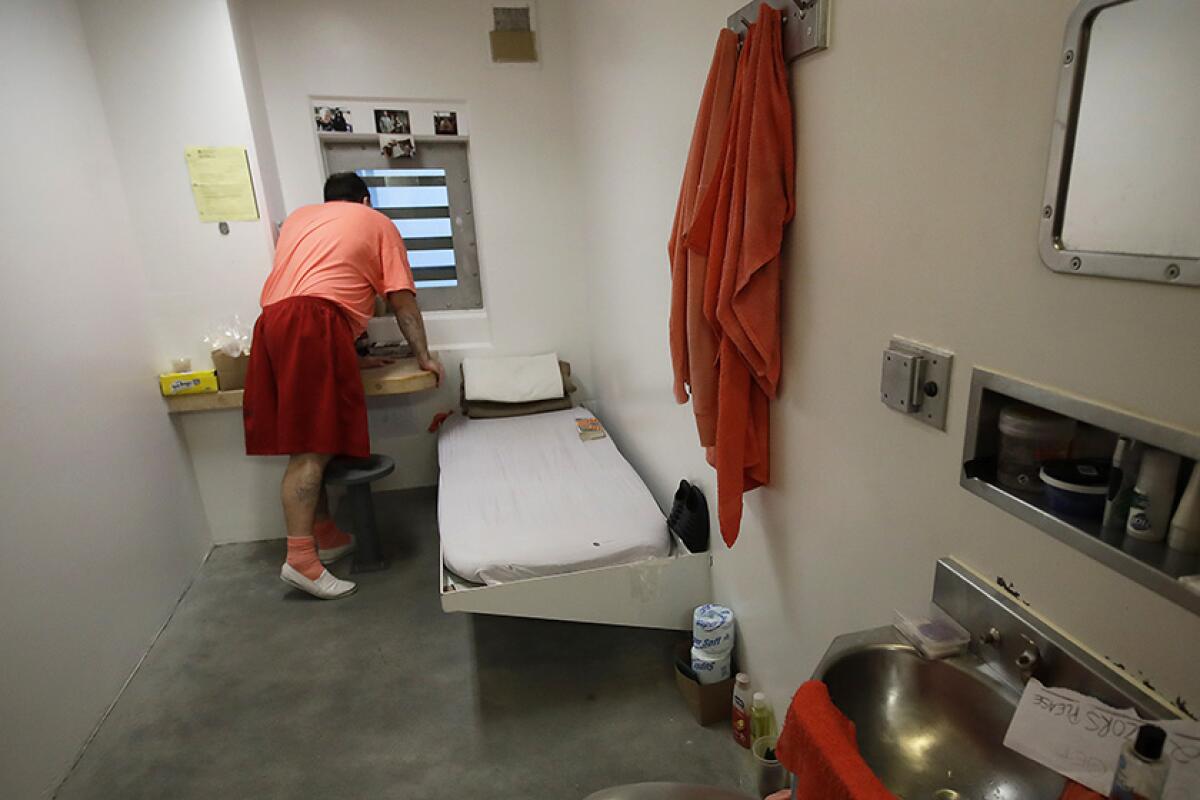Op-Ed: Here in San Quentin, I see why solitary confinement must end

Advocates almost succeeded this year in curbing the use of solitary confinement in Californiaās prisons and jails. The California Mandela Act, named after the long-imprisoned South African president, received the support it needed in August to pass the Assembly 41-16 and land on Gov. Gavin Newsomās desk. He vetoed the bill a month later, citing safety concerns.
That must not be the end of the fight against this torturous practice. Lawmakers should try again next year and every year until a governor signs those restrictions into law.
Solitary confinement has never been shown to decrease prison violence. Researchers have found that it leads to higher recidivism rates. Itās also the setting for a disproportionate number of prison suicides.
The numbers tell a damning enough story. Iāve also seen the toll firsthand.
Iāve spent more than 26 years in Californiaās prison system, including 13 reporting for San Quentin News, Solitary Watch and various other news outlets. I have talked to dozens of people who were subjected to solitary confinement for disruptive behavior, as well as those sent to solitary because they were deemed sick.
Solitary confinement is used for many reasons ā although prison officials who defend it are quick to say it is for the āsafety and security of the institution.ā
Everyone that Iāve interviewed about solitary confinement says the lingering effects of extreme isolation have stayed with them. Michael Sperling, 45, says his life path led him not only to incarceration but all the way to solitary confinement.
āMy dad shot me up when I was 12 years old,ā Sperling said, who is serving his 11th year of incarceration. He was sentenced to seven years to life for conspiracy to commit extortion. Sperling says his troubles began shortly after his father got him hooked on heroin. He began running the streets, where he found acceptance in a street gang. His incarceration history includes several stints in juvenile hall. While in California prisons, he says gang-related activity got him sent to solitary confinement three times.
Then thereās 36-year-old Terry Kitchen. Heās been incarcerated since he was 14 years old and is serving a life sentence at San Quentin. As Ireported recently, Kitchen was sent to a solitary confinement unit called the Adjustment Center after testing positive for COVID-19 last June.
āThe experience traumatized me,ā Kitchen said. In his Adjustment Center cell, he said, āThereās a little window [in the cell door] where all you can see is a wall. So your entertainment is watching spiders and ants walk around.ā
During his incarceration. Kitchen said he has been subjected to solitary confinement several times for disciplinary events. But being sent to solitary confinement for being sick was the worst, because the Adjustment Center is really like a dungeon.
William āMikeā Endres, 65, talked about being disciplinary action-free during his entire 24 years of incarceration, but lamented that prison officials āfound a way to put me in the hole for thinking I have COVID-19 when I didnāt.ā
Sperling described the effects of extreme isolation. āIn the SHU, itās very quiet,ā he said. āThat quiet and stillness becomes your worst enemy. When itās quiet like that, you can hear people talking about you in your head.ā
Sitting alone in a cell for 23 hours a day, for years and months, he added, āI see that I was slowly losing my mind.ā He talked about how even a solid person could begin thinking that all his friends were trying to get him, all from how a person looked at him or common gestures like waving or body language.
āSolitary confinement does no justice,ā Sperling said. āAll it does is deteriorate the great minds of great people. I am witness to it. I have seen it happen. I watched it happen.ā
Sperling noted the long-term effects that isolation has had on him. He is constantly paranoid and suspicious of peopleās intentions and actions as they move around him.
āI got so used to being alone and it being so quiet, all the noise in the mainline dorms and tiers of cells automatically annoys me,ā he said. āIām always thinking whether a person is trying to harm me or not. Iām constantly looking over my shoulder. Someone might be trying to help. But I canāt stop thinking about whether that person is trying to harm me.ā
Sperling opposes the use of solitary, āthe holeā in prison slang, because he says itās inhumane to lock someone in a cage all day like an animal. āIf someone misbehaves, the longest hole time they should get is a few days,ā he said. āLong-term hole time is wrong. Itās wrong in every way. Thereās no benefit in it.ā
In his veto message, Newsom said he is instead directing prison officials to improve the treatment of people subjected to solitary confinement ā an approach that is inadequate, at best, in dealing with a practice the United Nations has denounced as torture. Newsom said he believes the Mandela Act is too broad.
What is actually far too broad, however, is the use of solitary confinement in California.
Juan Moreno Haines is senior editor of the San Quentin News and a contributing writer at Solitary Watch.
More to Read
A cure for the common opinion
Get thought-provoking perspectives with our weekly newsletter.
You may occasionally receive promotional content from the Los Angeles Times.










